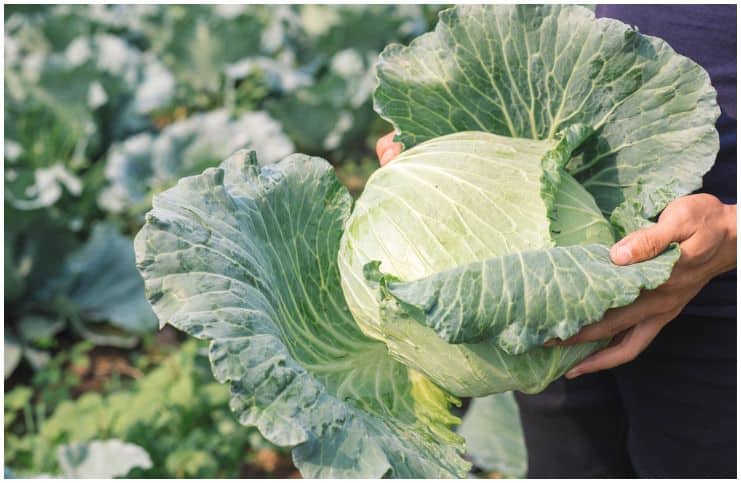Cabbage
It is an important member of the Brassicaceae or Cruciferae family, which also includes bok choy, broccoli, cauliflower, kale, and Brussel sprouts. In the present day, Poland, Japan, China, and Russia, are the leading producers worldwide.
This vegetable can vary in color from red to green and purple, and the leaves can be crinkled or smooth.
When cooked for long periods of time, it loses some of its nutrition content, therefore, to preserve this veggie’s many nutrients, it is best consumed as close to raw as possible.
Nutrition Facts
It is impressive with its high content levels of iron, calcium, potassium, iodine, sulfur, vitamin A, phosphorus, vitamin B1, vitamin B2, vitamin B6, vitamin B9, vitamin C, vitamin E, vitamin K, magnesium, beta-carotene, protein, dietary fiber, sulforaphane, zeaxanthin, and lutein.
Also, 100 grams of this vegetable contains 0.1 grams of fat and 24 calories, that will be great news for anyone calorie counting.
Health Benefits
Antioxidant Properties
Scientists have now identified about 15 different phenols and 20 different flavonoids in this cruciferous vegetable, all of which have potent antioxidant properties.
An Excellent Source Of Sulforaphane
The sulforaphane found in this vegetable may help protect against some types of cancer. According to a recent study, there is a 35 percent reduction in breast cancer when cruciferous vegetables were added to their regular diet by women.
Cardiovascular Health
It is high in potassium, an essential mineral that helps regulate blood pressure by counteracting the adverse effects of excess sodium in the human body.
A deficiency of this mineral can lead to weakness, fatigue, and constipation as well as respiratory failure, paralysis, and gut obstructions.
Fights Cancer
This vegetable is a source of anthocyanins (especially the red type). Anthocyanins are pigment compounds that also give berries and fruits their color. They increase programmed cell death of cancerous cells and scavenge free radicals, thus, lowering the chance of disease.
Also, this vegetable contains glucosinolates, that are transformed into isothiocyanates in the human body, and helps us in cancer prevention.
Also, a substance called DIM found in most cruciferous vegetables protects against the harmful effects of radiation during cancer therapy, as per a study conducted at Georgetown University Medical Center.
Thyroid Function
In the United States, over 21 million adults have some form of thyroid disease.
It is a good source of iodine, a mineral that helps in the proper functioning of the nervous system and the brain. Iodine is also required in the human diet to ensure that the thyroid works normally.
Prevents Depression
This cruciferous is also a remarkable source of vitamin C (about 36.6 mg/100 g), primarily when consumed fresh. The human body does not produce vitamin C on its own, therefore, it is essential to include plenty of vegetables and fruits rich in vitamin C in your regular nutrition.
This vitamin is vital for the healthy functioning of a variety of internal bodily systems. For instance, research on hospitalized people has proved that consuming foods rich in vitamin C can improve mood.
Side Effects
There are no side effects, however, overeating can interfere with the effectiveness of blood-thinning medications.
Lettuce
It has been cultivated for millennia and is characterized by large leaves, commonly green in color, but occasionally purple or red, depending on the variety.
Nutrition Facts
It is a good source of dietary fiber, vitamin K, vitamin A, vitamin C, vitamin B9 (better known as folate), iron, manganese, potassium, riboflavin, zinc, vitamin B6, niacin, vitamin B1, choline, sodium, pantothenic acid, copper, selenium, betaine, calcium, magnesium, and phosphorus.
Health Benefits
Heart Health
Folate, also referred to as vitamin B9, is a vitamin essential for women who are planning to become pregnant or who are pregnant. Also, it is needed to convert homocysteine, a non-protein α-amino acid, into other benign substances.
This is important since excessive amounts of homocysteine can raise the risk of stroke and heart attack.
Prevents Osteoporosis
It is an excellent source of vitamin K (approximately 39% of the recommended daily intake for women and 28% for men), a vitamin that helps you form blood clots. Also, according to recent research, this vitamin can help prevent osteoporosis even better than calcium can.
Good For Type 2 Diabetics
Dietary fiber is a substance which is not digested by the body, hence, it acts as a sponge to push waste through the intestinal tract. A regular diet rich in fiber has been strongly associated with a reduced risk of type 2 diabetes mellitus and heart disease.
Specifically, it is a soluble fiber that slows the absorption of sugar, helping with glycemic control.
Eye Health
This vegetable is a great source of vitamin A (in the form of beta-carotene), a potent antioxidant that is associated with the prevention of macular degeneration, the leading cause of age-related blindness in the world.
Side Effects
There are no known side effects.
Cabbage vs Lettuce – Which Has A Better Nutritional Profile?
Cabbage is superior from a nutritional point of view, especially regarding its fiber, vitamin C, and vitamin K content.
Image credit – Shutterstock
READ THIS NEXT: Broccoli vs Cauliflower
Resources https://www.ncbi.nlm.nih.gov/pubmed/24377584 https://www.ncbi.nlm.nih.gov/pmc/articles/PMC3915797/
